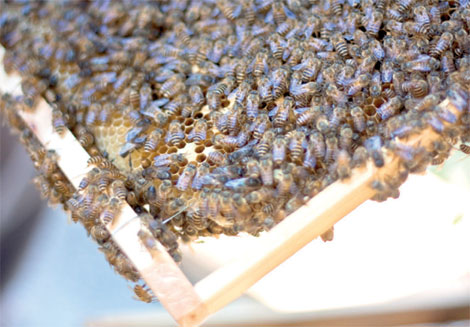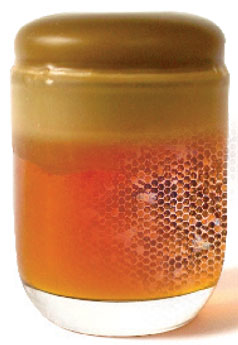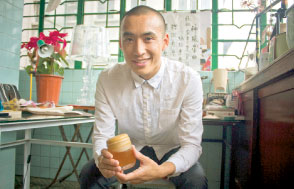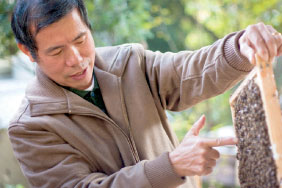Creating a buzz
Updated: 2011-02-09 07:56
By Christopher DeWolf(HK Edition)
|
|||||||||

With inflation a growing cause for concern, most people shake their heads in resignation; others, like designer Michael Leung, set out to do something about it. Leung, a journeyman bee keeper, has taken up the campaign to promote urban agriculture. Christopher DeWolf reports.
It's late on a sunny morning and Michael Leung is skulking around on the roof of an old factory building, tending to the potted flowers that feed his hungry workers: an army of 30,000 bees.
"Right now this roof is just used for smoking, but eventually we want to cover at least half of it with beehives," he says, gathering dead plants that he was too busy to water while participating in the Detour art and design festival last December.
|
Michael Leung was a product designer for Motorola before he moved to Hong Kong. "I wanted to do something more low-tech," he says. Christopher DeWolf / For China Daily |
The hives are housed in three wooden boxes, each with a small entrance giving bees access inside. As hundreds of bees pour out of the boxes, new bees arrive with bundles of pollen tucked under their appendages.
"Look," says Leung. "Some of the pollen is yellow, some is orange." He looked around at the surrounding walls and rooftops. His withered plants were the only green things in sight. "I'm not sure where they're getting it. Maybe it's one of the parks nearby."
Leung, a 27-year-old product designer, is an unlikely beekeeper. For one thing, he didn't know anything about bees more than a year ago. "I used to be really scared of them," he says. Now he is the brain behind HK Honey, a new project that aims to promote local food and urban agriculture by uniting Hong Kong beekeepers and designers.
"It's unclear where our food actually comes from," says Leung. "The goal is to introduce local food through a creative medium."
Born and raised in London, Leung moved to Hong Kong in 2009 to complete a master's degree at the Polytechnic University School of Design. It was a Christmas trip to visit his then-girlfriend's family in rural Sweden that sparked his interest in beekeeping.
"Her father had a couple of beehives and the materials and colors were the same as his house," says Leung. "As a designer, I was really interested. But it was interesting as a hobby, not as a design outlet."
That changed after he returned to Hong Kong and began to research beekeeping. "I began to contact people in Tokyo, Toronto and London who had been doing urban beekeeping," he says. "I started reading these hard-core books about bees, as well as beekeeping guides for dummies." He learned that bees pollinate dozens of crops, from onions to fennel and mangoes. "We depend on them," he says.
Hong Kong did not have any urban beekeepers, but it did have several bee farms located in suburban parts of the New Territories. After a visit to the Wing Wo Bee Farm, nestled into the hillside beneath the Ten Thousand Buddhas Monastery in Sha Tin, Leung became an eager apprentice to Yip Ki-hok, who has been keeping bees for more than 50 years.
|
Yip Ki-hok has been keeping bees since he was seven years old. Christopher DeWolf / For China Daily |
Yip taught him how to manage bee hives, how to extract honey and wax and, perhaps most importantly, how to deal with surprisingly complex bee politics. Every hive needs a queen bee, but when a queen becomes old, the hive produces a new heiress; sometimes, though, the old queen becomes jealous and murders the nascent queen. Other times, worker bees will mutiny and start a new hive of their own.
What Yip couldn't teach him was how to raise bees in the city. Though Wing Wo is less than 10 minutes from the Sha Tin MTR station, "it's essentially a rural farm," says Leung. "I want to show people that it can be done in the city, where we actually live."
Aside from rooftops, Leung envisions beehives being places on air conditioning platforms that become obsolete after people switch from window-box air conditioners to more modern split units. He is even thinking of ways to convert old air-con units into hives. "A hive could be pretty creative in its design," he says. "Anyone could have a beehive next to their window."
Though Yip sold Leung two hives to get his rooftop farm started, he was worried that the bees would struggle to adapt to their new urban environment, especially after he drove to Ngau Tau Kok with Leung and saw the barren rooftop for himself. Aside from a few small parks, the nearest natural areas are more than three kilometers away.
"It's a little far for bees to travel," says Yip. "It's like people. If you live in Sha Tin and you work in Sha Tin, how great is that? But if you live in Sha Tin and work on Hong Kong Island, that's very troublesome. Before the bees go off, they would consume just enough energy for them to fly to the site. The farther it is, the more they need to consume."
Things didn't look good at first. Normally, after being installed in a new location, it takes bees just half a day to find flowers. Leung's bees were gone for three full days before they returned to the hive with honey and pollen.

"I started to ask myself, is it ethical?" says Leung. When the bees started to produce honey, though, he was satisfied that he had not caused them any undue trouble. "They're able to thrive," he says. "I decided it's like someone who grew up in the countryside, who spent their whole life in the field, but who has dreams of moving to the city. It's harder, but there's a new landscape to fly around, new flowers to find."
HK Honey was formally launched last July. Since then, Leung has produced honey and beeswax candles, which are sold at local design boutiques Kapok and Daydream Nation. He has led educational candle-making workshops at Daydream Nation as well as a pop-up honey cafe at Detour. He has also been approached by several individuals and organizations that are interested in setting up rooftop bee farms of their own.
While Leung is a Hong Kong pioneer, urban beekeeping is already a well-established trend in Japan, Europe and North America. Paris in particular has become the apiary leader among world cities, with 400 hives in public parks, on apartment balconies and on the rooftops of several famous restaurants. Beekeepers estimate that Paris bees produce nearly twice as much honey as bees in the French countryside, owing to the urban heat island effect and the city's great variety of flowers.
In New York City, urban beekeeping has become so popular that city officials voted last March to reverse a long-standing ban on keeping honeybees. "The benefits of urban beekeeping are substantial," wrote anthropologist Hugh Raffles in the New York Times after the ban was revoked. Not only is local honey produced without pesticides or antibiotics, the pollen it contains can help reduce the severity of seasonal allergies, by acting as a sort of vaccine.
So far, the amount of interest generated by HK Honey has far outweighed the amount of honey Leung has produced. "Local food is still not prevalent in Hong Kong, but Michael has been successful because he's doing it in a fun, humorous way," says Marisa Yiu, who curated a designer exchange at Detour that sent Leung to learn about urban beekeeping in Tokyo. "Communication is the biggest barrier to promoting local food, and that's Michael's strength."
Nana Chan, a food writer who plans to open an organic cafe and community space in the spring, wants to use her new business to promote HK Honey. "He's doing more than just honey," she says. "He's showing people what you can do with rooftops, how you can live sustainability. When there's a story to something it's always more interesting."
Leung's design savvy and media-friendly image have had an impact beyond the limits of his project. With more attention being paid to local honey, farms like Wing Wo are seeing the benefit, too. Leung is working with Yip to redesign his brand and help him market his goods. "Until now, our business has been entirely word of mouth," says Yip.
Ultimately, though, the buzz is based on a simple truth: local honey is delicious. There's no better way to taste Hong Kong's terroir - the intersection between its unique geography and distinctive flora - than to sample seasonal honey.
Not only do flavors change every season, they vary by location. In the winter, says Yip, Wing Wo's bees favor the flowers of the ap geuk mok tree, which gives honey a rich, heady taste. Lychee and longan flavors predominate in spring honey. Summer honey bears the light, smoky essence of the wu kau flower. Autumn is usually a mix, with a less predictable flavor.
And Leung's rooftop honey? It's still a work in progress. "At this point, it's a light yellow, lighter than Mr Yip's," says Michael. "It's sweeter, too, with less distinct flower flavors. But we only have three hives right now. We'll see what's it like when we have 10."
(HK Edition 02/09/2011 page4)

